Taipei Times: Do you believe nuclear power can solve the world energy crisis?
Ian Lowe: If nuclear energy was the only way of preventing climate change, we should grit our teeth because the most optimistic studies — like the ones by the International Energy Agency — looking at how the world can reduce carbon emissions by at least 60 percent by 2050 looked at a range of scenarios. Even in the scenarios that did include nuclear power, it only accounted for 6 percent of the carbon emission reduction by 2050, with about 45 percent coming from other technologies and about 50 percent from improved efficiency.
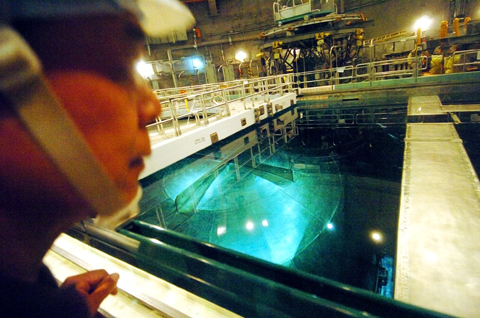
PHOTO: CHANG CHIA-MING, TAIPEI TIMES
TT: There is a belief that nuclear energy is the only source that can generate enough output to meet future demand, since wind and solar power are less reliable. Do you agree?
Lowe: About 10 years ago it looked like the nuclear power industry was dying, until [people] had this idea of revamping it as the solution to climate change. On one level it is valid to say that if the 456 nuclear reactors that are contributing to 15 percent of the world’s energy had not been operating, and instead we were burning coal to produce that energy, there would be more carbon dioxide in the air.
On another level you could equally say if that 15 percent of the energy was coming from wind turbines or solar energy, there would also be less carbon in the air. If you saw nuclear power as the answer, you would have to address [the fact] that uranium is also a limited resource.
There is enough high-grade uranium to keep the present nuclear reactors running for about 50 years, and they supply 15 percent of the world’s electricity. Nuclear energy is not renewable because it is depleting non-renewable resources like uranium. Some say it’s clean energy, but I think something that produces waste that lasts a million years isn’t very clean. There are talks about a new generation of nuclear energy that will be cleaner, but they have talked about it for 50 years.
Energy studies looked at what happens if we exhaust the high grade uranium ores and move to the low grade ones, and found that would produce as much carbon as burning gas because it would require digging and crushing rocks to extract the uranium. I don’t think nuclear [power] is an answer to the problem, particularly if you see an increase in energy demands in the future. While solar energy can’t be stored now, there are other renewable energies including wave and geothermal that are available 24 hours a day. But any form of renewable energy [is] variable, so it doesn’t make sense to rely on any one of them.
In the future the energy plant will be one that uses solar energy when there’s sun, wind turbines when there’s wind, and geothermal and wave at other times. Quoting [former US vice president] Al Gore, I say there isn’t a silver bullet, but there is silver buckshot; there isn’t one solution, but there are lot of little things that together solve the problem.
TT: How do you think a balance between environmental protection and economic development can be achieved?
Lowe: We should be doing social-environmental-economic analysis of all proposed new developments. At the moment we do very vigorous economic assessments, quite superficial environmental assessments and no social assessments at all. It’s obvious any significant development has environmental and social impacts; the issue of whether they are acceptable is a social value judgment.
In most political systems up till now, the presumption has been that any project that is economically viable should go ahead, unless there is undeniable evidence that there will be major environment damage. My view is that our fundamental duty to future generations is to maintain the integrity of natural systems.
TT: Do you feel that major nations left out of the Kyoto Protocol, such as the US and China, should begin to make reduction pledges?
Lowe: The second stage of the roadmap established at Kyoto, which will be negotiated in 2009 in Copenhagen, will be arrangements for the period 2012 to 2020. That would need to involve significant reduction in emissions from the developed countries.
The Kyoto roadmap was that the third stage would be the developed countries having shown their preparedness to reduce significantly, would be in a position to persuade the developing countries to set targets of significantly lowering emissions.
The US is certainly covered by the Kyoto Protocol, although the [former US president George W.] Bush administration didn’t ratify it, but China, India and Brazil were not targets of Kyoto.
Politically and morally that was correct, because at the time of the Kyoto meeting more than 80 percent of the carbon in the air came from the developed countries, and the first step had to be for them to stop increasing their emissions.
In terms of how we are going to go forward from here, if you looked at the carbon that is going into the air now, the US and China each account for about a quarter. Most other countries are not responsible for more than 2 percent, [so] there isn’t going to be a workable agreement unless the US and China are part of it.
Post-2020, the agreement certainly has to involve China. I heard ... that diplomats are trying to arrange a meeting between [US President Barack] Obama and the Chinese leaders because they have a shared interest in having a global arrangement. If they did reach an agreement, it would greatly encourage the countries that are responsible for the other half of the world’s emissions to make reduction efforts.
TT: Should countries like Taiwan expect to be demanded to make a contribution in the near future?
Lowe: If the roadmap is followed, after 2020 all countries will be part of the global arrangements to reduce carbon. 2020 is in 10 years. That means if countries like Taiwan were planning to build a coal-fired plant, for example, it is likely to incur a considerable cost post-2020. Rational planning now will be taking into account the quite high probability that after 2020 there will be a cost for emitting carbon and there will be financial penalties for not meeting targets.
Energy conservation is by far the most cost-effective way of reducing emissions.
Another thing governments can do is to change the regulatory framework by raising the bar for efficiency standards. It is noticeable that Europe and Japan responded to the 1970s oil crisis by significantly improving efficiency standard requirements for housing and offices in terms of electric appliances.
TT: How responsive do you think the public is to global warming ?
Lowe: So far I think most people still don’t get it. My partner said that people will only think it is serious when the rising sea level is lapping at their door handles. At one level I think it is reasonable to say that if the government is not taking it seriously, why should we?
Governments are more likely to respond if they think the people are worried about it, so the ACF has trained about 200 people to give the Australian version of the Al Gore slide show, and so far about 300,000 Australians have seen it.
TT: Do you think the climate change problem can be resolved?
Lowe: I’m cautiously optimistic. The reason I’m cautiously optimistic is that there is historical evidence that things can change very rapidly in human societies when enough people are aware of the problem and are determined to have change.
For example, the end of slavery, votes for women, or the end of the Berlin Wall and the end of apartheid in [South] Africa. Once the change had been made, it was very difficult to believe that people were prepared to accept the old way of doing things, or that it was so hard to change. I’m cautiously optimistic that enough of us are aware of the problem. Even if our efforts fail, I want to be able to tell my grandchildren that at least we tried.
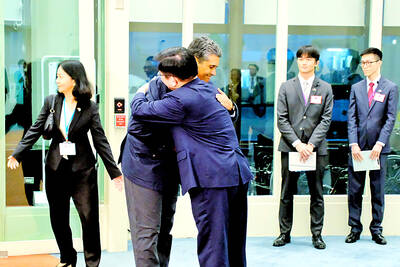
Palauan President Surangel Whipps Jr arrived in Taiwan last night to kick off his first visit to the country since beginning his second term earlier this year. After arriving at Taoyuan International Airport at around 6:30 pm, Whipps and his delegation were welcomed by Minister of Foreign Affairs Lin Chia-lung (林佳龍). Speaking to gathered media, the Palauan leader said he was excited and honored to be back in Taiwan on his first state visit to Taiwan since he was sworn in this January. Among those traveling with Whipps is Minister of State Gustav N. Aitaro, Public Infrastructure
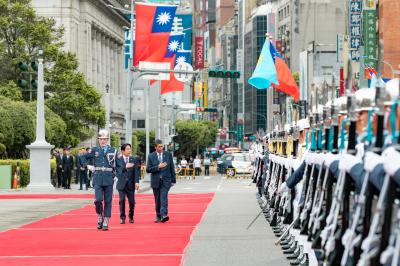
President William Lai (賴清德) yesterday thanked Palau for its continued support of Taiwan's international participation, as Taipei was once again excluded from the World Health Assembly (WHA) currently taking place in Switzerland. "Palau has never stopped voicing support for Taiwan" in the UN General Assembly, the WHO and other UN-affiliated agencies, Lai said during a bilateral meeting with visiting Palau President Surangel Whipps Jr. "We have been profoundly touched by these endorsements," Lai said, praising the Pacific island nation's firm support as "courageous." Lai's remarks came as Taiwan was excluded for the ninth consecutive year from the WHA, which is being held in
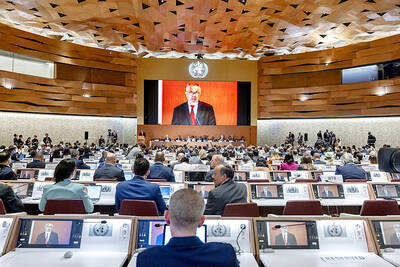
RESOLUTIONS DEBATE: Taiwan’s allies said that UN and WHA resolutions cited by China and other nations ‘do not determine Taiwan’s participation in WHO activities’ A proposal to invite Taiwan to this year’s World Health Assembly (WHA) was rejected on Monday, resulting in Taipei’s absence from the annual meeting for a ninth consecutive year, although partners spoke up for Taiwan’s participation at the first day of the meeting. The first agenda item after the opening was a “two-on-two debate” on a proposal to invite Taiwan to participate at the WHA as an observer. Similar to previous years, two countries made statements in favor of the proposal, while two others expressed their opposition. Philippine Secretary of Health Teodoro Herbosa, president of the 78th WHA, accepted the WHA General Committee’s
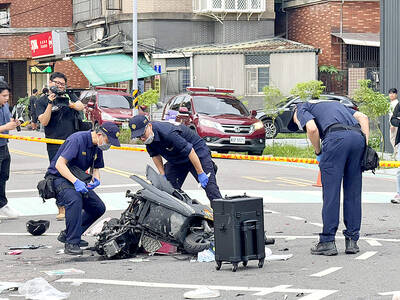
At least three people died and more than a dozen were injured yesterday afternoon when a vehicle struck a group of pedestrians in New Taipei City’s Sansia District (三峽). The incident happened at about 4pm when a car rammed into pedestrians at an intersection near Bei Da Elementary School. Witnesses said the sedan, being driven at a high speed, ran a red light, knocking scooters out of the way and hitting students crossing the road before careening into a median near the intersection of Guocheng and Guoguang streets. The incident resulted in three deaths and 13 injuries, including the driver, a 78-year-old man